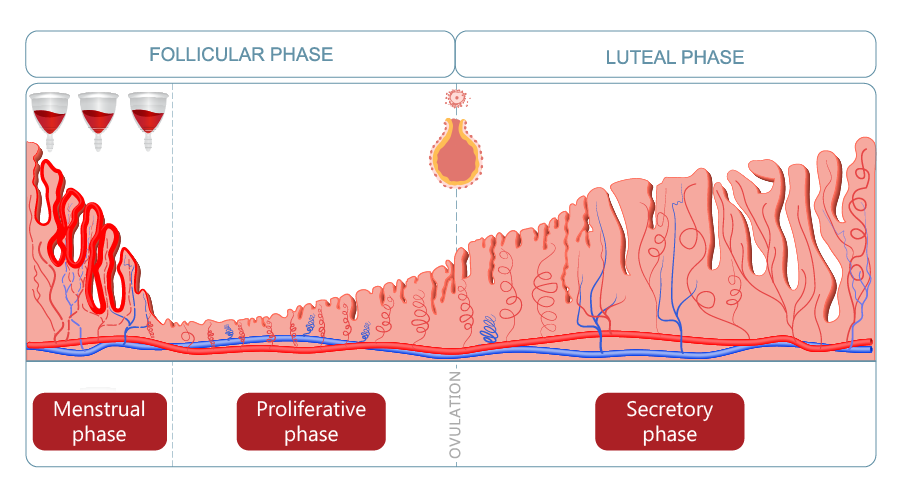The Uterine Cycle
During the menstrual cycle, the uterine lining (endometrium) cycles through three different phases:
- Menstrual Phase
- Proliferative Phase
- Secretory Phase

THE MENSTRUAL PHASE
The menstrual phase of the uterine cycle is when the lining of our uterus (the endometrium) is sloughing away and exiting the body through the vagina. This is known as menstruation. Menstruation occurs when levels of progesterone and oestrogen fall below a certain threshold because pregnancy has not occurred. The process of menstruation is also helped by the release of prostaglandins – chemicals that have hormone-like effects in our bodies. Prostaglandins cause our uterine lining to contract (hello, period cramps!). Diet, lifestyle and environment are three of the largest contributors to menstrual cramping and discomfort.
Prostaglandins sometimes also affect our lower intestines meaning we’re more likely to experience cramping and loose stools while menstruating.
Different women will experience different durations of bleeding, but generally between 4 – 8 days is considered normal. There is also a wide range of acceptable blood loss, with anywhere between 5 – 80mL considered a normal amount by official standards. If you have concerns about the quantity of blood loss you experience, using a menstrual cup can provide an easy way to measure.
Menstrual bleeding is usually heaviest during the first two days and it’s normal to notice some clumps or clots. After these first few days the volume of blood loss usually lessens. You may notice the colour of your period changes from being brighter during days of heavier flow to a more rusty/brown colour on days of lighter and slower flow. This is due to a process called oxidisation – the longer it takes for the blood to reach your menstrual pad, the more chance there is for the blood to come into contact with oxygen which causes a change to a browner colour. You likely won’t notice oxidisation so much if you’re using a menstrual cup. Ideally, your period should be a fresh deep red colour and not overly light or heavy.
A note on periods: A true period is any bleeding that has been preceded by a successful ovulation 10 – 16 days prior. Bleeding that was not preceded by a successful ovulation is generally called a breakthrough bleed.
PROLIFERATIVE PHASE
After the menstrual phase, the endometrium rapidly begins to regenerate and grow again. This stage is known as the proliferative stage. The growth of the endometrium during this time is due to the hormone oestrogen. Oestrogen is produced by follicles inside the ovaries as they grow larger in preparation for ovulation. The larger the follicles, the more oestrogen is produced! The proliferative phase varies in length.
SECRETORY PHASE
After ovulation occurs, the endometrium enters into the secretory phase. The lining that previously regenerated starts to become thicker and very nutrient-dense in preparation for a potential pregnancy. This is caused by the hormone progesterone. Progesterone is produced in the ovaries after ovulation has occurred. If a pregnancy doesn’t happen during this phase, progesterone and oestrogen levels drop and the endometrium begins to break down. The secretory phase is a fixed length of 10 – 16 days. After this time, menstruation begins and the cycle starts all over again.
